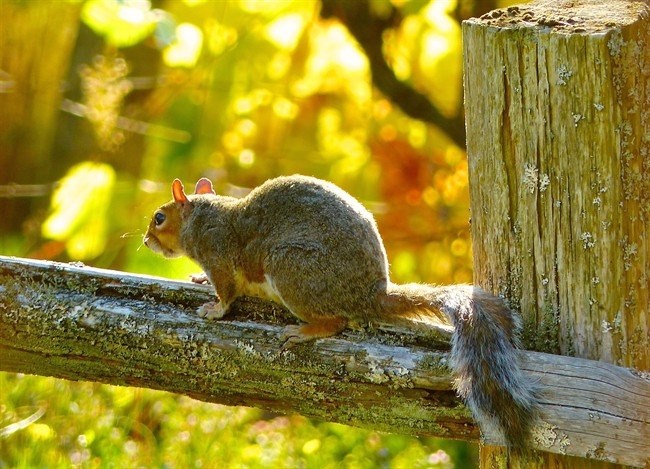
In this Tuesday, Oct. 13, 2015 photo, a tree squirrel, near Langley, Wash., is a voracious plant predator, eating everything from apples to flower bulbs. Chemical deterrents and frighteners are options for discouraging predator pests but savvy bulb gardeners shop for plants like daffodils, snowdrops and snowflakes that are distasteful to animals and rodents.
Image Credit: Dean Fosdick via AP
October 26, 2015 - 6:00 AM
Choosing the right kinds of flower bulbs to plant this fall is largely a matter of taste — bad taste.
If you're a gardener trying to defend against plant predators, look for bulbs that are noxious and unpalatable to foraging wildlife.
Members of the amaryllis family are the best long-term choice for predator control, particularly daffodils, snowdrops and snowflakes, said Christian Curless, a horticulturist with Colorblends, a wholesale bulb company in Bridgeport, Connecticut. All contain lycorine, an alkaloid both repellent and toxic to animals.
"It is incredibly bitter to the taste and, presumably, to the scent for deer and other fur-bearing animals that don't have to taste these plants to know they're off the menu," Curless said. "These plants we label as 'deer-and-rodent-proof' because even a starving animal won't eat them."
Plants described as predator "resistant," meanwhile, are a toxic step down from those called predator "proof."
"The bulbs we classify as 'resistant' are, for reasons we often don't understand, not preferred by deer or rodents or both," Curless said. Bulbs in this category include allium, hyacinth, fritillaria and anemone.
In the case of rodents, it can be harder to tell which bulbs will be resistant. "With rodents, you can plant bulbs and if they don't come up, nobody knows what happened," Curless said. Rodents like voles, moles and gophers are undercover agents — digging furtively beneath the snow or soil.
Deer are often considered gardeners' Enemy No. 1 for the damage they do in vegetable patches, orchards and flowerbeds, but there are many problem pests whose behaviour differs by region. Those range from armadillos to rabbits.
"In the Southwest, peccaries in herds can be significant garden pests, dangerous for dogs to tangle with," said Neil Soderstrom of Wingdale, New York, author of "Deer-Resistant Landscaping: Proven Advice and Strategies for Outwitting Deer and 20 Other Pesky Mammals" (Rodale, 2008). "A 400-pounder chased one of my Florida friends as she passed slowly in her car."
Mice, squirrels and chipmunks also are active bulb predators, said Mark Bridgen, director of Cornell University's Long Island Horticultural Research and Extension Center in Riverhead, New York.
"They dig up the bulbs to eat, or for other reasons like easy digging to store acorn seeds," Bridgen said.
Chemical deterrents and frighteners are options for discouraging bulb burglars, but their success has been mixed.
"Many are useful," Curless said. "Try them. See how it goes. Beyond that, don't stick with one. Deer are capable of becoming used to something that initially was unpopular with them. You run the risk of having them desensitized to it."
Fences 8 to 10 feet high are good control devices, but are costly and can run afoul of local zoning laws. They also might lead to unintended consequences.
"They may keep animals from your property, but that means shifting them over to somebody else's," Curless said. "And they'll exclude not only deer but other predators. If they can't get in to eat voles, they can create an enclave for other (predator) animals on your property."
___
Online:
For more, see this Cornell University master list of links to deer-resistant plants: http://www.gardening.cornell.edu/factsheets/deerdef
You can contact Dean Fosdick at deanfosdick@netscape.net
News from © The Canadian Press, 2015